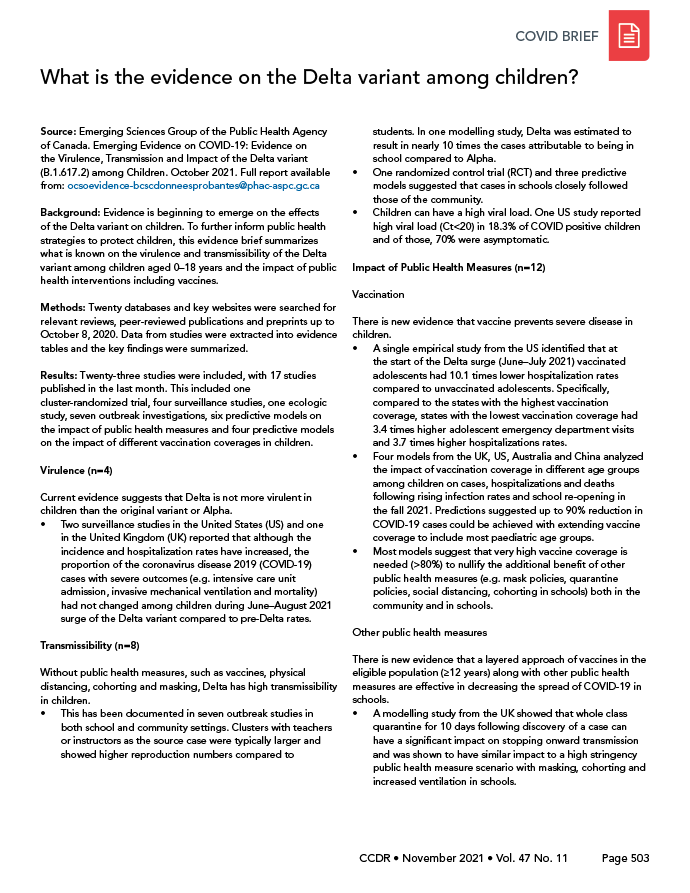Evidence of the Delta variant among children

 Download this article as a PDF
Download this article as a PDF Published by: The Public Health Agency of Canada
Issue: Volume 47 No. 11, November 2021: Multisystem Inflammatory Syndrome in Children
Date published: November 2021
ISSN: 1481-8531
Submit a manuscript
About CCDR
Browse
Volume 47 No. 11, November 2021: Multisystem Inflammatory Syndrome in Children
COVID Brief
What is the evidence on the Delta variant among children?
Source: Emerging Sciences Group of the Public Health Agency of Canada. Emerging Evidence on COVID-19: Evidence on the Virulence, Transmission and Impact of the Delta variant (B.1.617.2) among Children. October 2021. Full report available from: ocsoevidence-bcscdonneesprobantes@phac-aspc.gc.ca
Background: Evidence is beginning to emerge on the effects of the Delta variant on children. To further inform public health strategies to protect children, this evidence brief summarizes what is known on the virulence and transmissibility of the Delta variant among children aged 0–18 years and the impact of public health interventions including vaccines.
Methods: Twenty databases and key websites were searched for relevant reviews, peer-reviewed publications and preprints up to October 8, 2020. Data from studies were extracted into evidence tables and the key findings were summarized.
Results: Twenty-three studies were included, with 17 studies published in the last month. This included one cluster-randomized trial, four surveillance studies, one ecologic study, seven outbreak investigations, six predictive models on the impact of public health measures and four predictive models on the impact of different vaccination coverages in children.
Virulence (n=4)
Current evidence suggests that Delta is not more virulent in children than the original variant or Alpha.
- Two surveillance studies in the United States (US) and one in the United Kingdom (UK) reported that although the incidence and hospitalization rates have increased, the proportion of the coronavirus disease 2019 (COVID-19) cases with severe outcomes (e.g. intensive care unit admission, invasive mechanical ventilation and mortality) had not changed among children during June–August 2021 surge of the Delta variant compared to pre-Delta rates.
Transmissibility (n=8)
Without public health measures, such as vaccines, physical distancing, cohorting and masking, Delta has high transmissibility in children.
- This has been documented in seven outbreak studies in both school and community settings. Clusters with teachers or instructors as the source case were typically larger and showed higher reproduction numbers compared to students. In one modelling study, Delta was estimated to result in nearly 10 times the cases attributable to being in school compared to Alpha.
- One randomized control trial (RCT) and three predictive models suggested that cases in schools closely followed those of the community.
- Children can have a high viral load. One US study reported high viral load (Ct<20) in 18.3% of COVID positive children and of those, 70% were asymptomatic.
Impact of Public Health Measures (n=12)
Vaccination
There is new evidence that vaccine prevents severe disease in children.
- A single empirical study from the US identified that at the start of the Delta surge (June–July 2021) vaccinated adolescents had 10.1 times lower hospitalization rates compared to unvaccinated adolescents. Specifically, compared to the states with the highest vaccination coverage, states with the lowest vaccination coverage had 3.4 times higher adolescent emergency department visits and 3.7 times higher hospitalizations rates.
- Four models from the UK, US, Australia and China analyzed the impact of vaccination coverage in different age groups among children on cases, hospitalizations and deaths following rising infection rates and school re-opening in the fall 2021 Predictions suggested up to 90% reduction in COVID-19 cases could be achieved with extending vaccine coverage to include most paediatric age groups.
- Most models suggest that very high vaccine coverage is needed (>80%) to nullify the additional benefit of other public health measures (e.g. mask policies, quarantine policies, social distancing, cohorting in schools) both in the community and in schools.
Other public health measures
There is new evidence that a layered approach of vaccines in the eligible population (≥12 years) along with other public health measures are effective in decreasing the spread of COVID-19 in schools.
- A modelling study from the UK showed that whole class quarantine for 10 days following discovery of a case can have a significant impact on stopping onward transmission and was shown to have similar impact to a high stringency public health measure scenario with masking, cohorting and increased ventilation in schools.
- A US ecological study estimated that paediatric case rates in counties with school mask requirements experienced 18.53 fewer cases per 100,000 per day compared to counties without school mask requirements. Modelling studies have shown a protective impact of mask requirements in elementary, middle and high schools on school transmissions and community infection rates.
- Predictive models suggested that increasing the number of public health measures employed and higher vaccination coverage in the school and community populations were always more protective than fewer public health measures.
- The most effective public health measures varied across five modelling studies, but typically included mask requirements and either cohorting or testing strategies. It appears the combination of public health measures and vaccination coverage required to minimise risk of transmission in a school setting depends on the local epidemiology of COVID-19, and the feasibility of implementing different public health measures in a particular setting (e.g. schools) or for an activity (e.g. sports).
Conclusion: Based on preliminary evidence, the Delta variant in children does not appear to be more virulent than the original variant or Alpha. Without vaccines and other public health measures, however, Delta has high transmissibility in children. Current evidence indicates that vaccines and additional public health measures are effective in decreasing transmission of COVID-19 in schools. Empirical studies are needed to confirm, refute or qualify these findings.
Page details
- Date modified:
